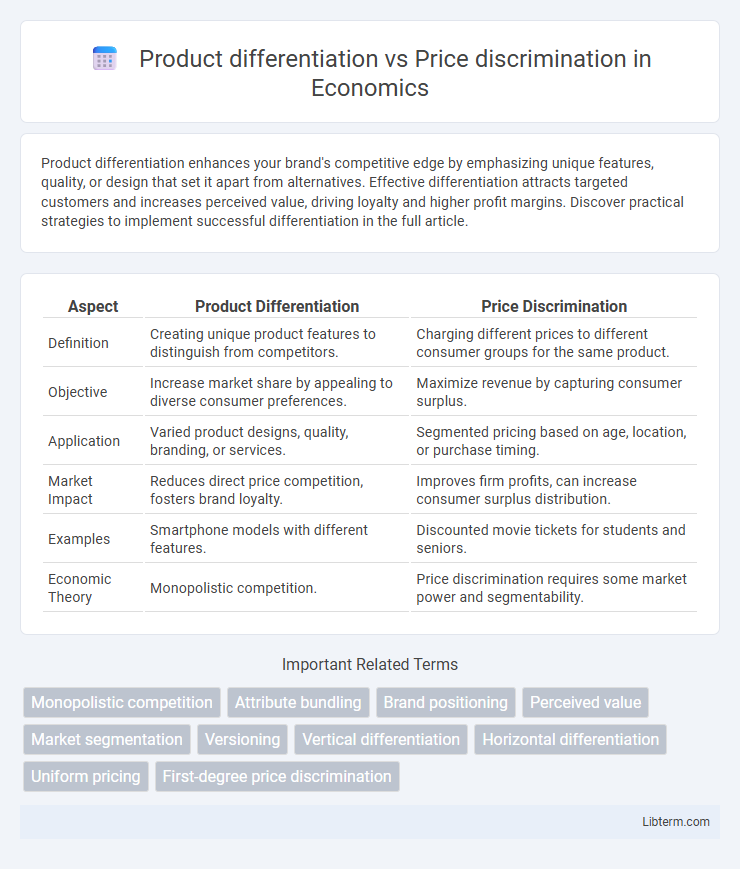Product differentiation enhances your brand's competitive edge by emphasizing unique features, quality, or design that set it apart from alternatives. Effective differentiation attracts targeted customers and increases perceived value, driving loyalty and higher profit margins. Discover practical strategies to implement successful differentiation in the full article.
Table of Comparison
| Aspect | Product Differentiation | Price Discrimination |
|---|---|---|
| Definition | Creating unique product features to distinguish from competitors. | Charging different prices to different consumer groups for the same product. |
| Objective | Increase market share by appealing to diverse consumer preferences. | Maximize revenue by capturing consumer surplus. |
| Application | Varied product designs, quality, branding, or services. | Segmented pricing based on age, location, or purchase timing. |
| Market Impact | Reduces direct price competition, fosters brand loyalty. | Improves firm profits, can increase consumer surplus distribution. |
| Examples | Smartphone models with different features. | Discounted movie tickets for students and seniors. |
| Economic Theory | Monopolistic competition. | Price discrimination requires some market power and segmentability. |
Introduction to Product Differentiation and Price Discrimination
Product differentiation involves creating distinct features, quality, or branding to make a product stand out in the market and appeal to specific consumer preferences. Price discrimination refers to the strategy where sellers charge different prices to different consumer groups based on willingness to pay, purchase timing, or quantity bought. Both practices aim to maximize firm revenue but differ in approach: differentiation enhances product uniqueness, while price discrimination leverages consumer segmentation for varied pricing.
Defining Product Differentiation
Product differentiation involves creating distinct product attributes that set a brand's offerings apart from competitors, enhancing perceived value through unique features, quality, design, or branding. This strategy targets diverse consumer preferences and segments by emphasizing variation rather than altering price points. Differentiation enables firms to avoid direct price competition and build customer loyalty by fulfilling specific needs with tailored product characteristics.
Understanding Price Discrimination
Price discrimination involves charging different prices to different customer segments for the same product based on willingness to pay, enhancing revenue without altering the product itself. It requires market segmentation and prevents resale between groups to maximize profits, common in airlines, universities, and software licensing. Understanding price discrimination helps businesses optimize pricing strategies and increase consumer surplus capture compared to product differentiation, which focuses on varying product features or quality.
Key Differences Between Product Differentiation and Price Discrimination
Product differentiation involves creating unique product features, quality, or branding to distinguish a product from competitors, targeting consumer preferences and enhancing perceived value. Price discrimination refers to charging different prices to different customers for the same product based on factors like purchase quantities, customer segments, or geographic location to maximize revenue. Key differences lie in product variation versus pricing strategy, with differentiation focusing on product attributes and price discrimination focusing on varied pricing for identical goods.
Types of Product Differentiation Strategies
Product differentiation strategies include quality differentiation, where companies enhance the durability or performance of products; feature differentiation, emphasizing unique attributes or functionalities; and service differentiation, offering superior customer support or guarantees. Another type involves brand differentiation, building a strong brand identity to create perceived value, while design differentiation focuses on aesthetic appeal and user experience. These strategies contrast with price discrimination, which segments customers based on willingness to pay rather than product variations.
Forms and Examples of Price Discrimination
Price discrimination involves charging different prices to different consumer groups based on willingness to pay, with forms including first-degree (perfect price discrimination where each customer pays their maximum), second-degree (prices vary by quantity or product version such as bulk discounts or premium editions), and third-degree (pricing based on identifiable groups like student or senior discounts). Examples include airline ticket pricing varying by booking time and class, movie theaters offering reduced prices for seniors, and software companies providing tiered subscription plans. Product differentiation, by contrast, focuses on creating unique product features or branding to justify price variations rather than explicitly segmenting consumers by price.
Impact on Consumer Choice and Market Dynamics
Product differentiation enhances consumer choice by offering diverse options tailored to different preferences, fostering competition based on quality, features, and branding. Price discrimination impacts market dynamics by allowing firms to capture consumer surplus, increasing market efficiency but potentially reducing consumer welfare for higher-paying segments. Together, these strategies influence demand elasticity, market segmentation, and overall price structures within competitive markets.
Advantages and Disadvantages for Businesses
Product differentiation allows businesses to target specific market segments by offering unique features, creating brand loyalty and reducing direct competition; however, it often involves higher production and marketing costs. Price discrimination enables firms to maximize revenue by charging different prices based on consumer willingness to pay, increasing market efficiency and profitability, but it may require complex pricing strategies and risk consumer backlash. Both strategies can enhance competitive advantage but demand careful market analysis to balance costs against potential gains.
Real-World Case Studies and Industry Examples
Product differentiation and price discrimination both serve as strategic tools to maximize firm profits but operate differently across industries. Apple exemplifies product differentiation by offering varied iPhone models with distinct features targeting specific market segments, thereby justifying premium pricing without altering cost structures. Airlines employ price discrimination through dynamic pricing and segmented ticket classes, capturing consumer surplus by charging different prices based on purchase timing and customer characteristics.
Conclusion: Choosing the Right Strategy
Selecting between product differentiation and price discrimination hinges on understanding target market segments and competitive dynamics. Product differentiation emphasizes unique features and branding to justify premium pricing, enhancing customer loyalty and market positioning. Price discrimination leverages varying willingness to pay across segments, optimizing revenue but requiring careful implementation to avoid customer alienation.
Product differentiation Infographic

 libterm.com
libterm.com